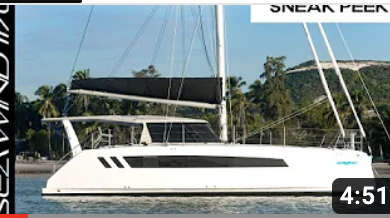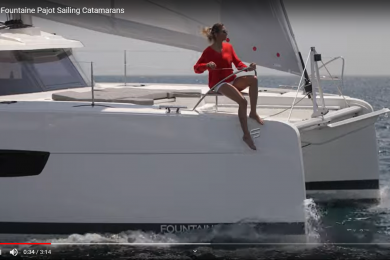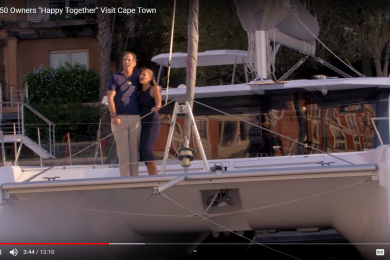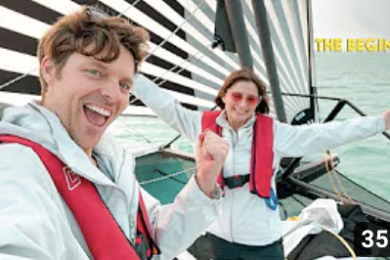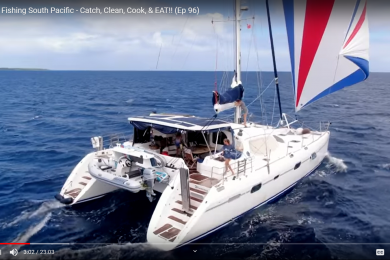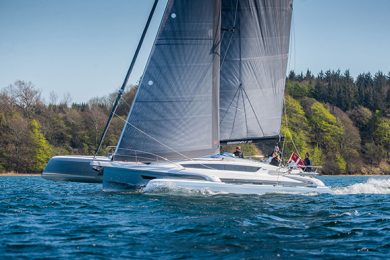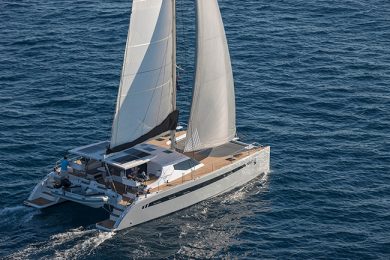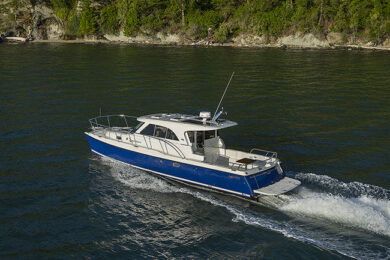The basics of maneuvering a catamaran (Published Spring 2016)
Catamarans have become “a thing.” Once a staple of sailing charter vacations, cats today are popping up all over the country, in hot and cold climates, and as power or sailboats. Increasingly, cats are being recognized for their many benefits; they offer more room in less length and can accommodate larger groups comfortably, they can be powered by smaller engines since they aren’t dragging a deep keel through the water, they usually provide more protection from the sun, wind and rain due to their deck layout, and they don’t heel much and move differently from monohulls so they can be a saving grace for those who are prone to seasickness. Finally, in some ways, they are easier to handle—once you learn to drive one, that is.
THE BASICS
It’s all about managing engine power and cats have the distinct advantage of having propellers set far apart so the boats will spin on the axis in their own length. When learning, it’s easiest to leave the rudders in a neutral position not only because messing with the wheel adds complexity, but also because at slow speeds, catamarans don’t need flow over the rudders to turn—the engines do the trick. If you have a rudder angle indicator, check to see that the rudders are centered. If you do not, spin the wheel from lock to lock and then cut the number of turns in half to figure out where centered position is.
Once the rudders are centered, you can lean on the wheel with your body to keep it steady as you work the throttles with your hands. Imagine holding a bar with both hands in front of you. Moving your right hand forward will move your left hand aft. Notice how your shoulders turn and in which direction you end up facing. Now apply this to the throttles. Powering forward with the starboard engine and aft with the port, will turn the cat to port and vice versa. Practice this near a soft buoy until you get the hang of it before approaching a dock or other boats. At this point, half the battle is won.
DOCKING AND DEPARTURE
Leaving a portside tie-up with boats both fore and aft like at a fuel dock, put a fender on your port quarter. Then put the port engine in forward and the starboard engine in reverse until the bows pivot out, clearing the boat ahead, and drive forward with both engines. If there is limited space forward, back out but first put a fender on your port bow to cushion any contact. Then put the starboard engine in forward and the port in reverse until the transoms clear the boat behind and back out by using reverse on both engines.
It is possible to “walk” a cat by doing the above in short increments and moving the entire boat sideways and away from the dock. This works well if there is little wind or current.
It’s easier to dock a catamaran in reverse because the captain is usually closer to the stern and has better visibility aft and also because propellers work more efficiently in forward then reverse so if the docking procedure goes awry, you can power forward out of trouble faster.
Coming to a port side tie up, put a fender on your port quarter, come along and slightly ahead of the space where you want to end up on a busy quay. Pivot so that your stern angles about 45 degrees to the dock with the port engine in forward and the starboard in reverse. Power aft slowly with both engines and just before the fender makes contact, keep the port engine in reverse and put the starboard into forward to pivot into the dock.
Coming in bow to, put a fender on the port bow, angle the bows in, and as the boat slips in, put the port engine in forward and the starboard in reverse until you come alongside and can have someone step off the transom to get lines ashore.
A spring line is helpful when departing or approaching a dock and it should be the last/first line ashore. When using a spring line at departure to help pivot the boat without it moving too far forward or aft, it’s easiest to loop the line on a dock cleat and then double it back aboard. That way, crew can let go of their end when the line is no longer needed and quickly pull it aboard. Make sure not to leave lines in the water too long if the propellers are turning.
Med-mooring and backing into a slip are easier on a catamaran than a monohull. To back into a slip (which will make it more convenient for crew to step on and off) pull up until perpendicular with the slip, pivot the boat with the engines and then use both in reverse, adjusting as you back up if there is a beam wind.
For med-mooring, come abeam of the spot on the dock where you plan to tie up. Pivot the boat with the engines until you are lined up with stern to the dock, drop the anchor and have someone pay out the rode slowly as you back with both engines. It’s best to have lots of room to do this so you can set the anchor part way back. Once the anchor is set, keep backing and letting out scope (adjusting side to side with the engines as necessary) until you come close enough to the dock to have crew step ashore and tie up the stern lines. Make sure to have fenders tied directly aft to cushion the transoms. You can power forward if approaching the dock or quay too fast. Then have crew tighten up on the anchor rode with the windlass. The longer the run aft to the dock, the better so the anchor has time to bite.
You may want to start a bit to windward when backing against a beam wind.
WIND CURRENT, AND THRUST
It’s usually best to work against the current for better control. If departing a portside dock tie with the current coming from the bow, put a fender on the port quarter, power forward with the port engine and reverse with the starboard. If the current is coming from behind, back out, putting the starboard engine into forward and the port into reverse, pivot and then back out with both engines.

Catamarans have high hulls and cabin houses and therefore, more windage. This can be a bear when approaching or leaving a dock if the wind is working against you, and that’s why thrust matters. Depending on the situation, equal thrust may not get the desired results. In tight quarters, you may need to turn more sharply without contacting boats ahead or behind.
When leaving a portside dock with the current ahead, put the port engine slightly in forward to keep from backing up and put a fender on the port quarter. Apply greater thrust in reverse to the starboard engine to pivot until the bows are clear. Then put the starboard engine into forward (slightly) and apply more forward thrust with the port engine to pull clear and motor away.

PICKING UP A MOORING
To minimize swinging on a mooring, and to keep it quieter for anyone sleeping in the forward cabins, use two lines to hook a cat up to a mooring. Attach one line to each of the forward cleats and bring the loose ends to the center. Pick up the mooring with a boathook and find the eye—often well below the float. String one line through the eye and bring it back to the same cleat. Repeat on the other side, keeping the lines the same length so the cat is centered. It’s best if you have at least two people to do this quickly but one can manage while you keep station with the engines, pivoting as above to give crew time to tie up.
Remind your crew that due to the high bow, you will lose sight of the mooring long before the boat is near enough for them to reach the float. Communication will be key to make sure you are lined up on the mooring and do not overrun it.
LESSONS LEARNED
Most cats have mini-keels to help them track. Others, like Catanas, have daggerboards that may be retracted into the hull. Coming into a shallow anchorage, it may be intuitive to raise the boards all the way up to avoid grounding. However, the round hull bottoms will provide little grip and picking up a mooring or anchoring in windy conditions will make the cat slip around like on a bar of soap. Leaving a foot or so of the daggerboards down will provide enough traction to spin and maneuver as you need. Check the chart to see how much to leave down when venturing into skinny waters.
If you have a sufficient number of crew members in a docking situation, keep one person mobile with a fender so they can assist wherever there is need, fore or aft. Never ask anyone to jump off the bow—cats are high and injury is possible so have them step off the transom step.

Catamarans don’t coast well primarily because they don’t have a deep keel to track. Relying on coasting to a dock at a shallow angle and then going to reverse and using prop walk to cozy up the stern won’t work as well as on a monohull. It is better to come in at a sharper angle and then pivot the boat into position with the engines especially if there is little room fore and aft.
Depending on design, visibility is not always great from the helm of a catamaran to either forward corner or to the transoms. If you have crew, work out a communications system in advance where you can see and hear them give direction and remind them that you can’t hear in high wind, and you can’t stop a large cat on a dime so no last minute panicked looks back at the driver.
PRACTICE, PRACTICE, PRACTICE
There is no substitute for practice, not only to learn the basics, but also to get the nuances of a particular boat. Spending an hour docking in various situations will probably garner you an audience, but after several successful landings, they’ll not only cheer, they may admit (if only to themselves) that they should be out there doing just the same, learning to dance with a cat.

